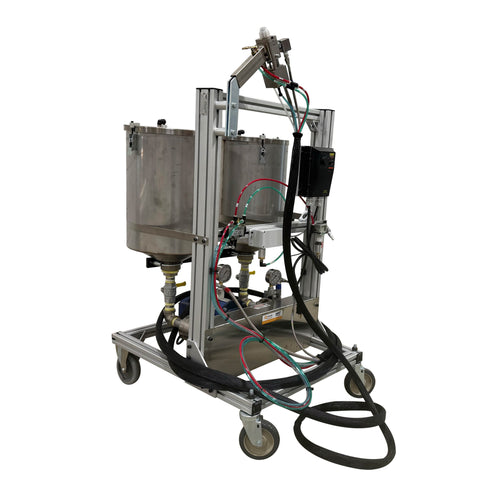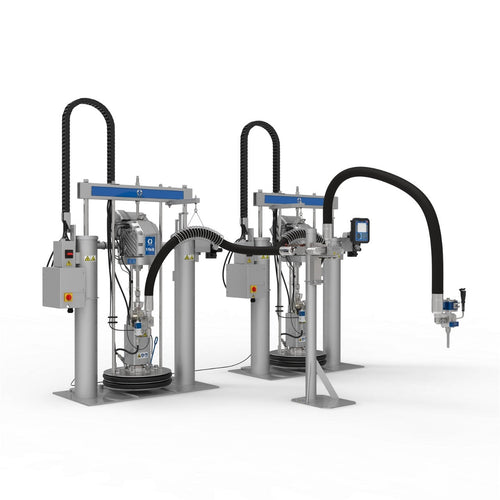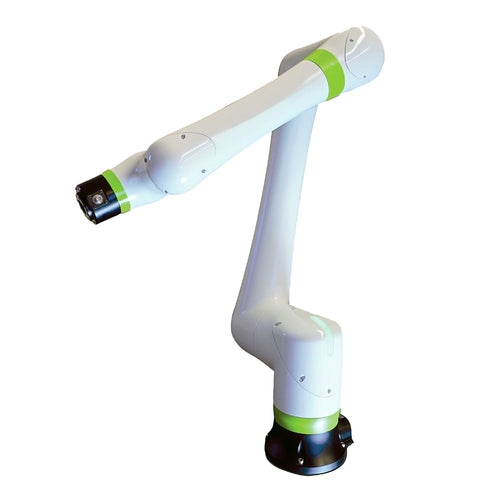Table of Contents:
- What Are Thermal Interface Materials
- Types of TIM Materials
- How to Dispense TIMs
- Dispensing Methods
- Equipment Recommendations
- Tips for Working with TIMs
- FAQs
Overheating can be a significant problem with electronics. This can cause significant malfunctioning of the device that could lead to dangerous consequences in some cases. Fortunately, there are ways to help prevent overheating and regulate heat with thermal interface materials.
What Are Thermal Interface Materials (TIMs)?
Thermal interface materials (TIMs) are substances used to improve thermal conductivity between two or more solid mating surfaces. These surfaces are usually a heat-generating component and a heatsink.
While the mating surfaces appear to be flat against one another, there are small holes that get filled with air between them. This air has a low thermal conductivity that can lead to thermal resistance between the surfaces. Thermal interface materials are used to fill those microscopic gaps to facilitate more efficient heat transfer and provide better thermal management between the surfaces.
Thermal interface materials are commonly used with electronics. EV batteries in cars, planes, and motorcycles are a popular application, but they can also be used with heat spreaders, power modules, or data centers.
Types of Thermal Interface Materials
There are several different types of thermal interface materials. Each has their own pros, cons, and properties that may make them better suited for a specific application.
The different types of thermal interface materials include:
-
Thermal greases/pastes
-
Thermal adhesives
-
Thermal pads
-
Phase change materials
-
Gap fillers
Which one you should choose will largely depend on your application including factors such as the thermal conductivity, flexibility, compressibility, electrical insulation, and long-term stability needed.
1. Thermal Greases and Pastes
One of the most common types of TIMs, thermal greases and pastes are usually made of a silicone base and have a higher viscosity. They have great conformability and are cost-effective. Thermal conductive pastes and greases also have better heat conductivity than some other types of thermal interface materials, so they are best suited for high-performance applications where this is necessary. Thermal greases and pastes may also degrade over time.
Applying and dispensing thermal greases and pastes may be done with manual syringes, but volumetric systems are usually recommended for higher-volume or higher-speed production. Volumetric TIMs dispensers can also lead to better precision and consistency.
2. Thermal Adhesives
Thermally conductive adhesives are great for both their thermal conductivity and bonding capabilities. They are ideal for heavy-duty applications where they must improve heat transfer between two surfaces as well as act as an adhesive.
Made of two-components, thermal paste glues usually require meter mix dispensing systems to ensure accurate ratios and dispensing of the TIMs materials.
3. Gap Fillers
Thermal gap fillers are a type of soft thermal interface material that is generally silicone-based and used to fill larger gaps or uneven surfaces. They have low total thermal resistance and high thermal conductivity. They also have a high tack and can easily wet out the surface. They are not compressible. Volumetric TIMs dispensing systems are usually used to ensure accurate mixing of these materials. Robotic dispensing systems may also be another option to ensure consistency.
4. Pads and Films
Another of the most common types of TIMs, thermal pads and films are pre-formed solid sheets that come in a uniform thickness. They come ready to use and are easy to apply without dispensing equipment. Thermal conductive pads and films are best suited for applications where precise thickness is required, but they only offer moderate heat transfer compared to some other types of TIMs.
5. Phase Change Materials (PCMs)
Phase change materials are similar to thermal pads as they are solid at room temperature, but they will soften when heated during device operation. This property allows them to easily conform to surface irregularities to increase thermal contact. PCMs are often not dispensed, but instead pre-applied to components or applied using stencil printing or custom film lamination.
Dispensing Thermal Interface Materials
Not only are there multiple different types of TIMs materials, but there are also so many different formulations. TIMs can be created with different chemistries for a wide range of properties and applications. Consequently, dispensing TIMs materials can get complicated.
You need the right amount of the TIMs material, in the correct spot, and in a consistent manner for good results. Poor application can lead to insufficient heat transfer, material migration, contamination, or mechanical stress on the system. Especially for more precise applications, accuracy and consistency are critical.
A disadvantage to thermal interface materials is that they can be more difficult to dispense compared to other materials. Often, they are heavily filled with glass beads and can be rough or abrasive which may even lead to equipment damage. They also tend to be thicker and more viscous. Not to mention the fact that two-component TIMs need precise mixing for accurate results. Altogether, these factors can make them more difficult to dispense and get accurate results.
Dispensing Methods for TIMs
Although dispensing these materials can prove challenging, there are different ways to dispense TIMs materials and a lot of equipment available. The different methods for dispensing thermal interface materials can include:
Manual Syringe Dispensing
-
A manual application method
-
Best for low-volume applications and slower production speeds
-
Can lead to inconsistent results from human error
Time-Pressure Systems
-
Uses air pressure and time-based controls to dispense TIMs materials
-
Cost-effective but sensitive to viscosity changes
-
No real process control
Jet Dispensing
-
Non-contact, high-speed dispensing
-
Tricky to do with highly abrasive or filled TIMs materials
-
May require more sophisticated and complex setups
-
More expensive
Volumetric Dispensing
-
Uses screw, piston, or gear pumps
-
Volumetric process control
-
Excellent accuracy, consistency, and precision
-
Good for high-viscosity or abrasive TIMs
-
Ideal for high-volume and high-speed applications
-
Easy to automate
Recommended TIMs Materials Dispensers
Having been in the dispensing industry for many years, our team has seen their fair share of TIMs materials dispensing equipment. While there are many systems that are compatible with TIMs dispensing, not all of them will be the best choice. Our team is sharing some of our favorite dispensing equipment for thermal interface materials for you to check out.
This electric variable ratio system can handle 1:1 to 5:1 or 2:1 to 10:1, ratios. Each pump is also controlled by it owns electric motor. For thicker, more viscous materials like TIMs, this means you have the torque to dispense at a high flow rate while still being able to manage variable ratios.
Because TIMs materials can be extremely hard on any equipment, the system comes in configurations with elite series pumps and valves. These components can drastically increase the service life of the equipment for long-lasting success.
If you ever have a material change, this equipment makes it easy. The variable ratio setup means you can change ratios without changing your hardware. The base purge feature also allows you to run the material through the machine without worrying about wasted material curing in the static mixer.
Finally, the equipment has a user-friendly interface and allows for flexible configurations for easy setup and different automation opportunities.
This electronic fixed ratio system is a tried-and-true system for meter mixing and dispensing of two-component materials. It provides accurate, reliable, and consistent dispensing of shots and beads for different materials.
Like the EVR, the equipment can be configured with ultra durable Z pumps and elite series hardware to prevent the TIMs materials from running down the machine and decreasing the equipment's lifespan.
The system is also designed with ease of use in mind. It has an intuitive interface that beginners can easily configure and operate. The equipment also requires minimal maintenance.
This servo-driven shot meter is another option for a TIMs dispenser as its durable design works well with highly abrasive and viscous materials. It can work with 1:1 to 5:1 or 2:1 to 10:1 ratio ranges and is made with precision in mind. The system also features a patented first-in-first-out (FIFO) fluid path to prevent material buildup. This equipment can be remote mounted on a gantry system or a robotic arm, like a cobot dispensing arm, for easy automation.
How well a piece of equipment works largely depends on the specific material being used and the application. If you are not sure what equipment to use, we want to help. Contact our team, and we will work with you to help you determine the equipment we need.
Tips for Dispensing TIMs
Even if you are using the right type of thermal interface material and equipment, there is still the opportunity for errors to occur. To ensure you get the best results, here are a few tips for dispensing thermal interface materials to ensure accuracy and efficiency.
-
Always test the material with your equipment first.A material compatibility test can confirm that the material you are using works with the equipment and your application.
-
Regularly clean and perform maintenance on your equipment. Thermal interface materials can be especially hard on equipment. Regular maintenance and cleaning can reduce buildup and help increase the lifespan of your equipment.
-
Find a material supplier that will work with your equipment team. This could help minimize issues at startup as well as help you more quickly address any issue that could arise later.
-
Automate when possible. For high-volume production especially, automated dispensing systems ensure repeatability and accuracy without sacrificing speed.
-
Be mindful of the production environment. Changes in humidity or temperature can impact the viscosity of the TIM and impact flow.
-
Choose compatible parts. Always match the dispensing tips or nozzles, for example, to the material's particle size and flow characteristics.
Dispensing TIMs is more than just one step in the assembly line. It is a precise process that can directly impact the performance of the end product. Especially as electronics become more powerful and miniaturized, investing in high-precision dispensing and automation is becoming more and more critical.
If you need help with your thermal interface dispensing process, contact us to discuss your needs and equipment options. We can provide free technical consultations to help you optimize your dispensing processes.












